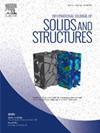Three-dimensional buckling analysis of stiffened plates with complex geometries using energy element method
IF 3.4
3区 工程技术
Q1 MECHANICS
International Journal of Solids and Structures
Pub Date : 2024-10-18
DOI:10.1016/j.ijsolstr.2024.113105
引用次数: 0
Abstract
A novel numerical method, energy element method (EEM), is proposed for the three-dimensional (3D) buckling analysis of stiffened plates with complex geometries. The problem is formulated in a cuboidal domain, and any complex geometric stiffened plate is modeled by assigning cutouts within the cuboidal domain. The stiffened plate is considered as an energy body and is discretized using Gauss points with variable stiffness properties to simulate its energy distribution. Incorporating the extended interval integration, Gauss quadrature, variable stiffness properties, and Chebyshev polynomials, the strain energy of stiffened plates with complex geometries can be numerically simulated by putting the stiffness and thickness of Gauss points in the cutouts to zero in the cuboidal domain. Using the principle of minimum potential energy and Ritz solution procedure, the deformation and buckling behaviors of stiffened plates with complex geometries can be captured. As a result of the new formulations in EEM, new standard energy functionals and solving procedures have been developed. In addition, Gauss points are generated within the energy elements accounting for the geometric boundaries of the stiffened plate, which are characterized by level set functions. EEM is employed to investigate complex-shaped stiffened plates with straight or curvilinear stiffeners, and the results are compared to those obtained using FEM or mesh-free method. The precision, generalization, and stability of EEM are demonstrated.
利用能量元素法对具有复杂几何形状的加劲板进行三维屈曲分析
针对具有复杂几何形状的加劲板的三维(3D)屈曲分析,提出了一种新的数值方法--能量元素法(EEM)。问题在一个立方体域中提出,通过在立方体域中分配切口来模拟任何复杂几何加劲板。加劲板被视为一个能量体,使用具有可变刚度属性的高斯点进行离散化,以模拟其能量分布。结合扩展区间积分、高斯四则运算、可变刚度特性和切比雪夫多项式,通过在长方体域内将切口中高斯点的刚度和厚度置零,可对具有复杂几何形状的加劲板的应变能进行数值模拟。利用最小势能原理和 Ritz 求解程序,可以捕捉到具有复杂几何形状的加劲板的变形和屈曲行为。在 EEM 中采用新公式后,还开发了新的标准能量函数和求解程序。此外,还在能量元素内生成了高斯点,这些高斯点反映了加劲板的几何边界,并以水平集函数为特征。EEM 用于研究带有直线或曲线加强筋的复杂形状加强板,并将结果与使用有限元或无网格方法获得的结果进行比较。证明了 EEM 的精确性、通用性和稳定性。
本文章由计算机程序翻译,如有差异,请以英文原文为准。
求助全文
约1分钟内获得全文
求助全文
来源期刊
CiteScore
6.70
自引率
8.30%
发文量
405
审稿时长
70 days
期刊介绍:
The International Journal of Solids and Structures has as its objective the publication and dissemination of original research in Mechanics of Solids and Structures as a field of Applied Science and Engineering. It fosters thus the exchange of ideas among workers in different parts of the world and also among workers who emphasize different aspects of the foundations and applications of the field.
Standing as it does at the cross-roads of Materials Science, Life Sciences, Mathematics, Physics and Engineering Design, the Mechanics of Solids and Structures is experiencing considerable growth as a result of recent technological advances. The Journal, by providing an international medium of communication, is encouraging this growth and is encompassing all aspects of the field from the more classical problems of structural analysis to mechanics of solids continually interacting with other media and including fracture, flow, wave propagation, heat transfer, thermal effects in solids, optimum design methods, model analysis, structural topology and numerical techniques. Interest extends to both inorganic and organic solids and structures.

 求助内容:
求助内容: 应助结果提醒方式:
应助结果提醒方式:


